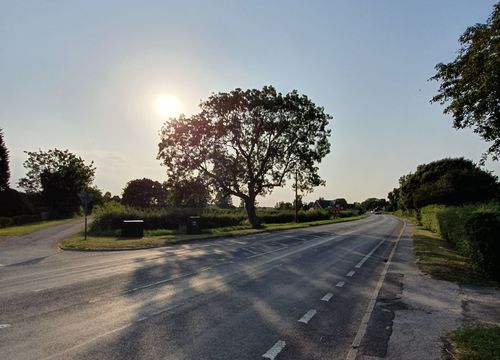
The North Great Road, Sutton-on-Trent.H A W C 101 / CC
Escaping to the North or heading south to seek your fortune? For centuries, if you wanted to go north, this is the way you went.
They call the M25 the “world’s largest car park,” and there are plenty of times it deserves the epithet. Landing at Heathrow and picking up a car, however, if you want to go north, that’s the way you go. I wanted to go north. So, I turned the black Peugeot to the motorway and headed for Watford. Midweek, midday, the traffic thins out as you pass the junction with the M40, peeling off northwest to Oxford.
Read more
More specifically, I wanted to go north “the way you go” not in the early 21st century, but the way you went in the centuries between prehistory and the 20th century. On the motoring atlas today, the road doesn’t exist, but it lies all around and under the road known as the A1. I wanted to travel the Great North Road.
The longest numbered road in Britain is the A1, connecting London with the Scottish capital of Edinburgh. Originally designed and designated by the Ministry of Transport in 1921, the A1 was in effect the beginning of the modern British national road system. Over the decades its route has been revised and parts of the A1 upgraded to motorway status. The building of the M1, too, which follows much the same regional direction, has changed the A1 from being the way north to being one way north.
Aficionados of the A1 claim it as the closest thing the British have to a cult highway—sort of the equivalent of America’s Route 66. In fact, however, the A1 itself is a latecomer across the landscape. For centuries, long before the A1 bypassed villages and market squares, the way between London and Edinburgh was known simply as the Great North Road.
The only actual road building ever undertaken in Britain had been done by the Romans. After their legions withdrew from the island, the whole infrastructure of roads, urban centers, and country villas were left to wither away through the centuries. Celts, Anglo-Saxons, Vikings, and Normans all still had to travel, though, however uncomfortable and cumbersome their progress across the countryside might be.
By the early Middle Ages, the Great North Road had evolved as the single unified route between London and North Britain. In part, it followed stretches of Roman Dere Street, in part, it followed the natural topography of the landscape and long-familiar routes between villages and market towns. For centuries, rough carts and springless wagons, horses, and shank’s mare took pilgrims and Crusaders, bishops and noblewomen, drifters, and highwaymen between London and the northern ecclesiastical and political center of York, or on to Durham or Scotland. Generations of adventuring Scots took the road south to seek life in more prosperous England—like James Boswell, who famously wrote of his road adventures with the inimitable Samuel Johnson.
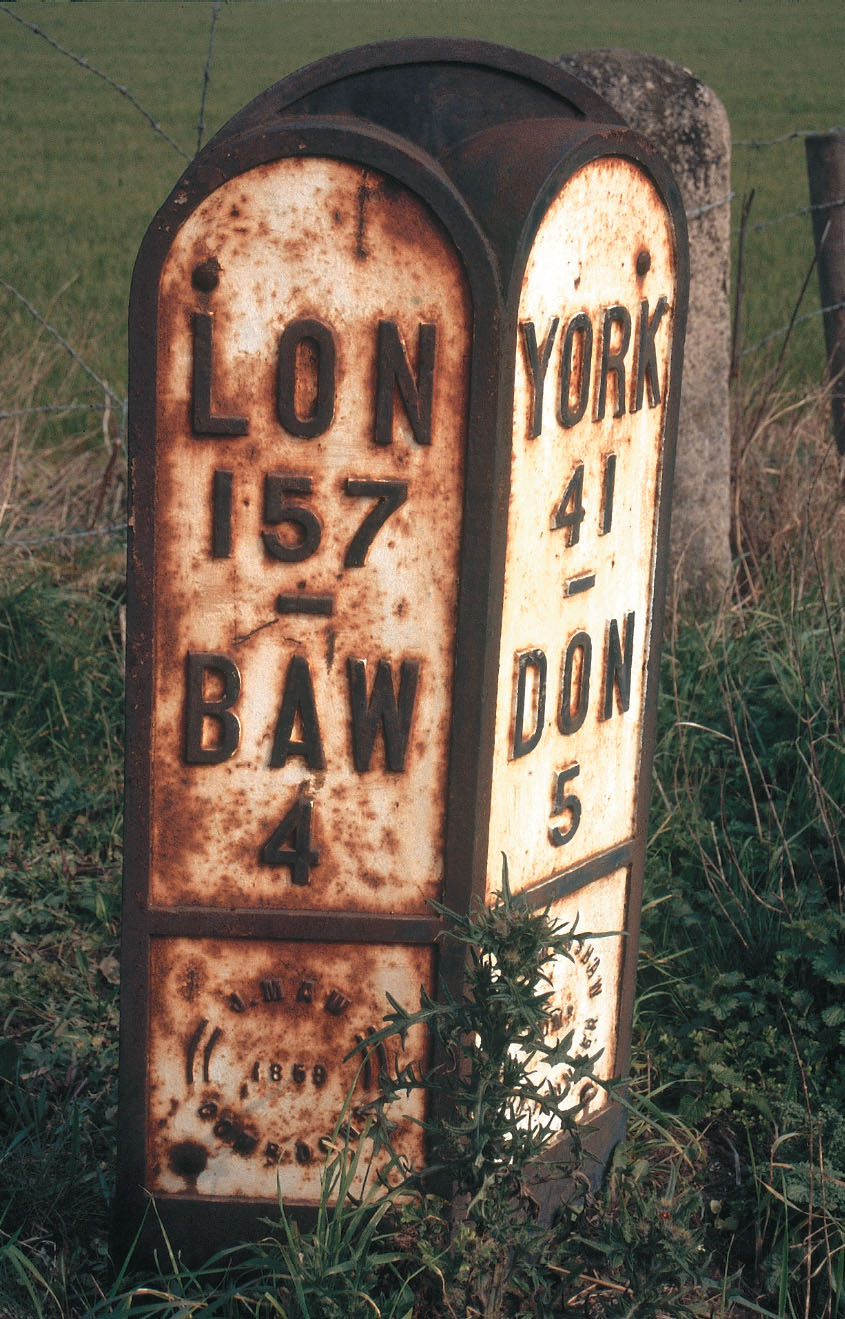
Rusting mile markers line the way on the Great North Road.
By the time Boswell and Dr. Johnson traveled the Great North Road in the late 18th century, improvements were well underway on both the road and the means of travel upon it. It must have seemed a state-of-the-art luxury, indeed, to traverse roads that were somewhat graded and maintained by recently established local “turnpike trusts,” which often financed the work with user fees that were collected at toll booths. Sprung stagecoaches now plied the road on regular routes and fixed schedules—a considerable improvement over the plodding wagons of bygone years. Along the route of the Great North Road, the infrastructure of travel evolved, with inns and public houses growing up along the way as surely as fast-food franchises and lodging chains mark the popular paths of road travel today. Travel time from London to Edinburgh was cut from 12 days to four in the 18th century. What adventures would I find today, I wondered, during four days on the Great North Road?
You can follow the Great North Road out of London all the way from Smithfield in the City along Clerkenwell Road, up Highgate Hill, through Finchley and Barnett, but I opted to pick up the route at Potters Bar, where the old Great North Road crosses the M25.
It is not the A1 here that leads north on the old alignments of the Great North Road, but the A1000 meandering through what has become London’s nondescript northern suburbs to Hertfordshire and past the gates of Hatfield House—where Queen Elizabeth I spent part of her childhood.
If I was expecting many visual clues as to the route’s antiquity and historic significance in the Home Counties, though, I was soon proven mistaken. Where the road passed through pockets of relative affluence, there were building activities, smart petrol stations, Tesco and chain pubs. Where the road traversed pockets of relative neglect, the detritus left behind was the junk and jumble of the disposal-prone 20th century. As is unhappily so often the case these days, though, one has to go far from London to get deep into England.
Stamford
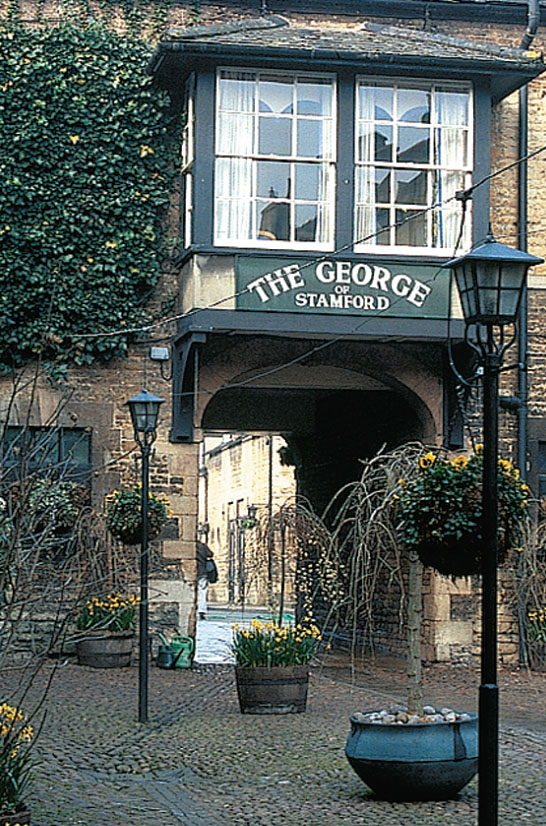
DANA HUNTLEY
My destination that first night on the road was Stamford. Exactly a day’s journey on the Great North Road from London by stagecoach, the town became prosperous during the coaching era as the East Midland’s transportation hub.
There are few places more deeply English than this market town on the southern edge of Lincolnshire—which modestly trumpets its reputation as one of the prettiest stone towns in England. I put up at the George Hotel, which has been an inn for 1,000 years. Word has had time to get around, and George has long been a hostelry of great renown. In crusading times, Knights of St. John of Jerusalem strolled in the garden in their black capes with white crosses. King Charles I was the first of a handful of royals to enjoy its hospitality; Sir Walter Scott was a frequent guest.
In George’s heyday as a coaching inn, it handled 40 coaches a day, “twenty up and twenty down.” Walking into the hotel today, to the right is the York Bar, to the left the London Room, where passengers would assemble for their coaches in the dark-paneled waiting rooms. Modernization of the hotel in recent years has taken great care to preserve its hard-won historical features and ambiance.
Stamford itself is a quintessential market town, with a pedestrianized shopping precinct on High Street, a Broad Street for the weekly market, a local history museum, arts center and tourist information office, a medieval almshouse, ancient churches, pubs and eating options. Its weekly newspaper, the Stamford Mercury, claims to be England’s oldest (1695). Adjacent to the town is the estates of Burghley House, the grandest of the country’s Elizabethan stately homes (we visit Burghley House in January’s British Heritage). Yes, Stamford would be a lovely place to take a day or two to visit.
Grantham
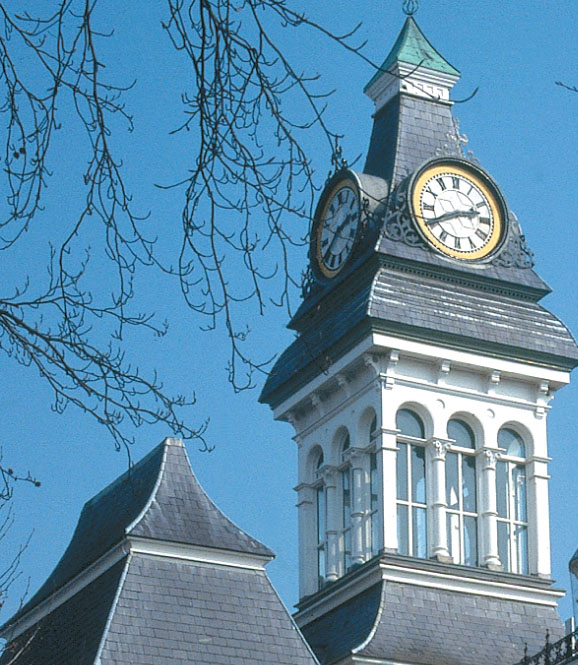
Grantham.
Like countless travelers before, though, I reluctantly left the George the next day in the fog to turn again north. At Lincolnshire’s northern edge lies the market town of Grantham. The Victorian Guildhall stands behind the statue of Isaac Newton, the town’s most famous son. Its most famous daughter grew up over a corner grocery on Broad Street operated by her father. Margaret Thatcher can rightly claim to be the only British prime minister born and raised right on the Great North Road. Grantham too has its old coaching inn, the Angel and Royal. King Richard III was staying here in 1483 when he signed the warrant for the execution of Lord Buckingham.
Shortly north of Grantham, the Great North Road crosses through the western corner of Nottinghamshire. Though the A1 follows the general route of the Great North Road, I didn’t spend much time on the A1 itself. From London to Northumbria the A1 is a dual carriageway and heavily trafficked; the miles on it go quickly and as nondescriptly as most highway travel.
For much of the route, however, the old road weaves east and west of the A1, often following what is now B-roads. By the time I reached my modern coaching inn in West Retford that evening, I had traveled the B197, B645, B1043, B1081, B1174, A6065, B1164, A6075 and A638. You do have to pay attention to navigation. British Heritage writer Tim Lynch drove down from Pilley, Yorkshire, to join me for dinner.
Just a few miles from the market town of Retford, the oldest alignment of the Great North Road meanders through the little village of Scrooby and past the farmyard gates of Scrooby Manor. Exactly 400 years ago, the resident lord was William Brewster, master of the Queen’s Posts. The Separatist congregation that would later become known as the Pilgrims, already in trouble with the law, was meeting at Brewster’s manor house. The next year, the group would leave this pastoral countryside behind forever and make its successful clandestine escape to the Netherlands. The village pub at Scrooby is appropriately named The Pilgrim Fathers.
Scrooby
 7
7
Scrooby.
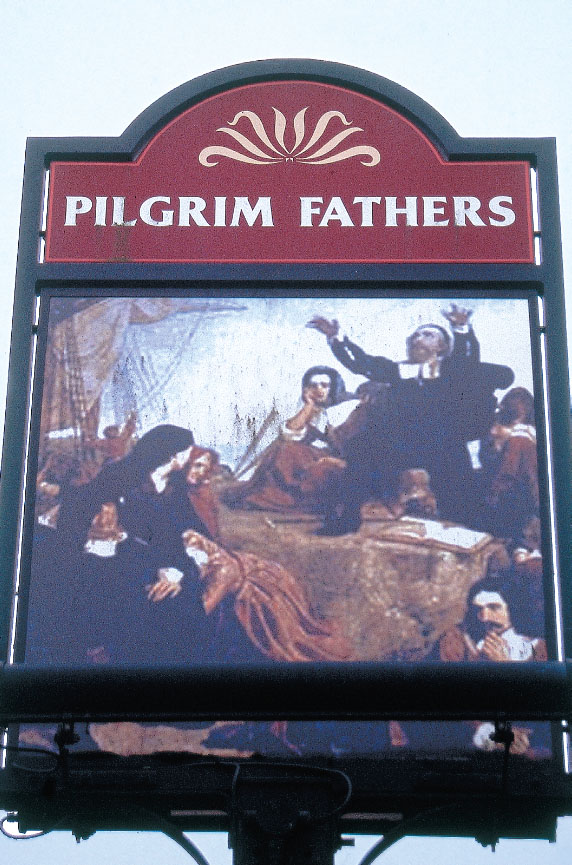
Scrooby.
ABIT FARTHER on, at Bawtry, I detoured a mile or two to Austerfield, which also proudly announces itself on its village signs as “Birthplace of William Bradford, Pilgrim Father.” The village pub is The Mayflower. It struck me as somehow ironic that the Pilgrim congregation should be pilgrims from instead of pilgrims on the Great North Road.
Along much of the Great North Road, the tracks of Britain’s main East Coast rail line run in rough parallel. Driving along, I was often semi-startled by a sudden who-o-sh of GNER trains racing past—carrying passengers between London and Edinburgh (and points betwixt) in as many hours as it took days to travel the Road in stagecoach. Crawling through the suburbs and downtown industrial Doncaster reminded me that those rails carry freight as well.
Darlington
 7
7
DANA HUNTLEY
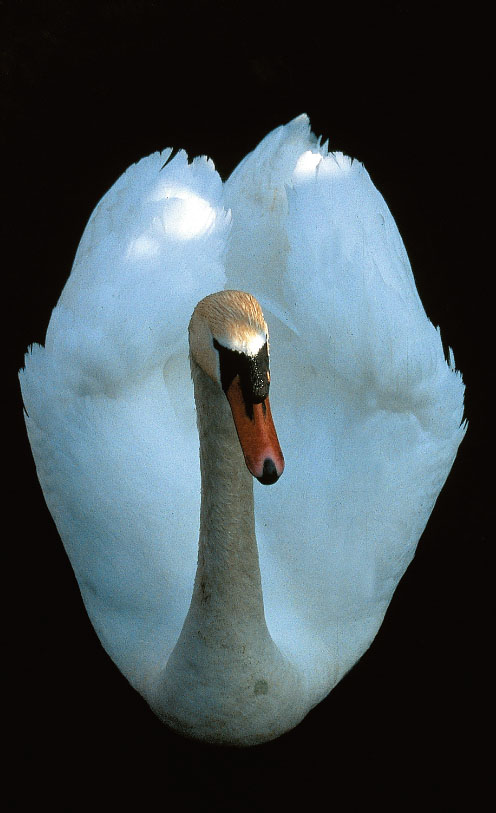
DANA HUNTLEY
Other rail and industrial centers lay ahead, Darlington and Newcastle. More often, however, that afternoon I jumped on and off the A1, weaving into many long bypassed villages that exuded English rural character, like Wentbridge, Wetherbury, and the ancient Roman town of Boroughbridge. Remarkably enough, though, the way is not particularly scenic, crossing Yorkshire with the famous Yorkshire Dales to the east and the North York Moors to the west.
There is no question if the Great North Road headed north, I was there, and the weather was socking in. The clouds hung dark gray and very low across the northern sky. A foggy mist enveloped the diminishing light as I drove through Darlington during its rush hour and on to the ancient cathedral city of Durham and a room at the Three Tuns coaching inn. That evening, I walked the quiet city center in the fog, the market place and precincts below majestic Durham Cathedral, and ate supper in the pub watching England play Andorra in the European Cup qualifying matches. England won, to the relief of all.
The damp, darkling weather continued the next day as I headed north again for Newcastle and Northumbria. By now, I might have expected to see signs announcing that I was on the Great South Road, but no, wherever the old route is identified, it is still the North Road. Most commonly, I entered towns on what was named the London Road and left them behind on a road named for the next market town ahead. I had also passed a lot of pubs in the past several days named the Coach and Horses.
Gateshead
 7
7
DANA HUNTLEY
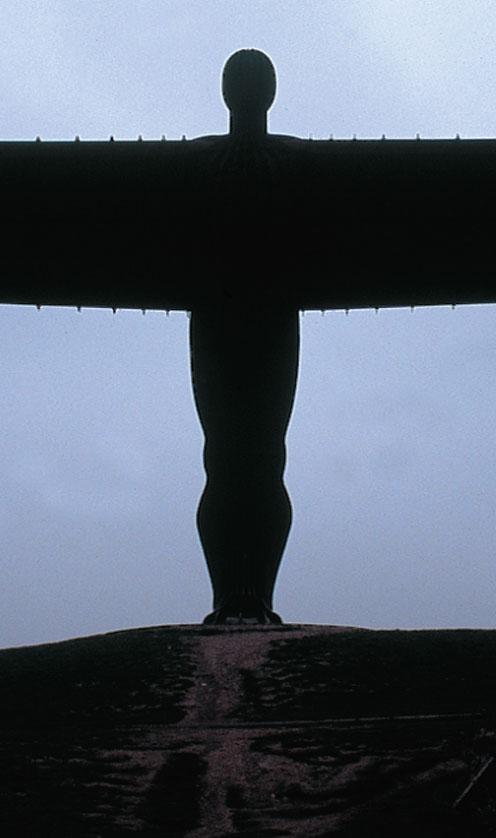
DANA HUNTLEY
At Gateshead, the industrial southern suburb of Newcastle-upon-Tyne, the road leads past Britain’s largest sculpture, the Angel of the North. Created by sculptor Antony Gormley in 1997, it is one of the most-viewed pieces of art in the world, seen by 33 million people a year. The angel is fabricated from 200 tons of weathering steel. It rises 65 feet and has a wingspan of 175 feet—almost the size of a jumbo jet. Beneath where it stands, coal miners worked the earth for 200 years.
Crossing the Tyne into Newcastle, I was right in the heart of England’s northernmost major industrial city. The skyline on both sides of the river down toward Tynemouth is pocked with remnants of the city’s shipbuilding industry. Coal from Newcastle traveled south by ship long before the railroad arrived. Inevitably, I got lost in the city center tangle trying to follow the original route of the Great North Road through congested city streets.
Above Newcastle, Northumbria spreads wide, wild and desolate. From Durham north, the village churches tend to be named for Celtic rather than Roman saints—St. Ninian, St. Hild, St. Cuthbert, and Bede.
The rain was constant as I parked to explore the stone market town of Morpeth, the county town of Northumberland. I escaped the weather with a visit to the bagpipe museum. The Highland bagpipes of Scotland may be the best-known variety of the instrument, but there are bagpipes from around the world in Morpeth, and the Northumbrian small pipes have played indigenous regional music for centuries.
Some 15 miles to the north, I left the still busy A1 aside to pass through Alnwick, in its own way the functioning capital of the county throughout the Middle Ages. Fishermen will know the town as headquarters of the House of Hardy, who has a company museum to the history of their famous rods and tackle. Book lovers flock to one of England’s largest second-hand bookstores, filling the old railroad station with its stacks. But Alnwick’s real claim to fame is Alnwick Castle, ancestral seat of the Percys, earls, and dukes of Northumberland since 1309.
Alnwick Castle, the family digs, is second only to Windsor as the largest inhabited castle in Britain.
The Great North Road enters Scotland at Berwick-upon-Tweed. Over the centuries, the border market town has changed national identity a number of times, now England, now Scotland and back again. There are old castle ruins and the town wall remains to be seen, but it’s not a particularly attractive town. I had thought to stay at the old coaching inn, but they wanted way too much for bed and breakfast. So, with several hours of misty gray light left, I turned east and detoured to follow the Tweed through Coldstream to the old border abbey town of Kelso. I put up at Kelso’s old coaching inn, the Cross Keys, on the broad, cobbled Market Square.
The next day, the BBC promised the weather would clear by midday, but it was still gray as I set out to regain the A1 and the last stretch of the Great North Road to Midlothian and on to Edinburgh. North of Berwick, the road often follows right along the North Sea coast before turning west along the Firth of Forth to the Scottish capital.
The Great North Road is a ghost road; the specters of a millennium of history are often lost in the commuting traffic and lorries that jostle the A1 today. It’s not a particularly pretty drive. For a glimpse of scenic Britain, there are many more salubrious options—the Lake District, the Cotswolds, Dartmoor, or those Yorkshire Dales. As a travel experience in England and Scotland, however, the legendary route offers a remarkable cross-section of Britain’s past and present, just as it did to travelers heading north or south by stagecoach 200 years ago.
From Dunbar at the mouth of the firth, the old road is now swallowed by a succession of towns that used to be unique communities but now are commuting suburbs for the city—Haddington, Tranent, and Musselburgh, full of traffic and fish and chips shops. Imperceptibly the suburbs become the city of Edinburgh, where the Great North Road and the A1 end unceremoniously on the eastern end of Princes Street.
Or is Princes Street where the road begins?
* Originally published in 2016.





Comments